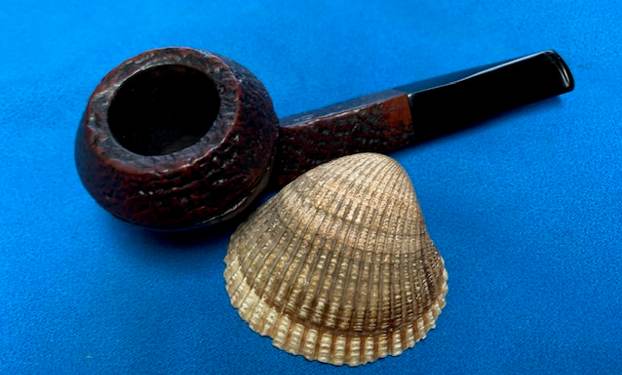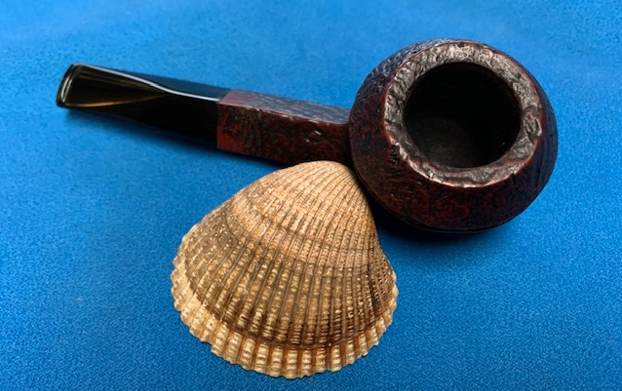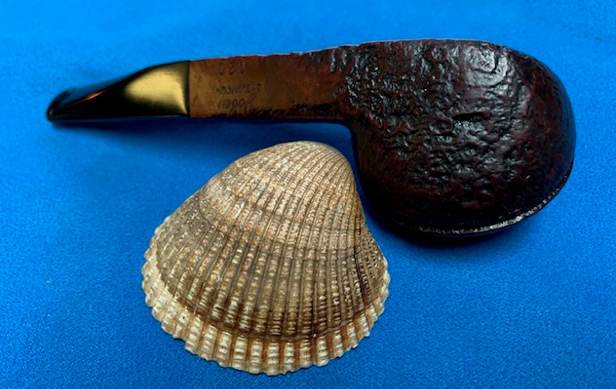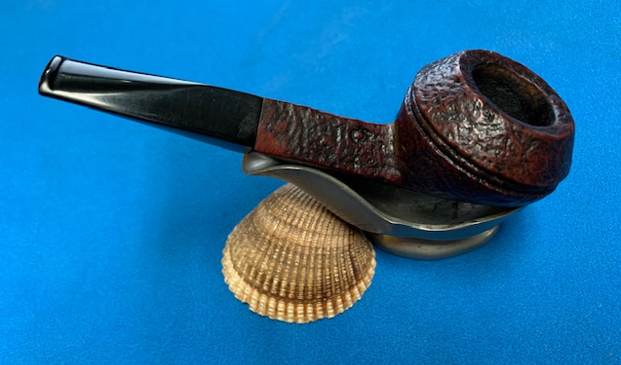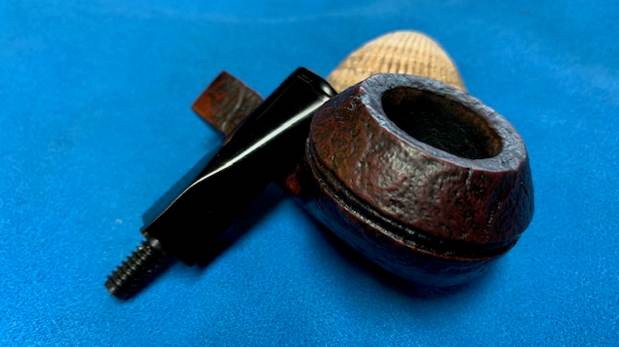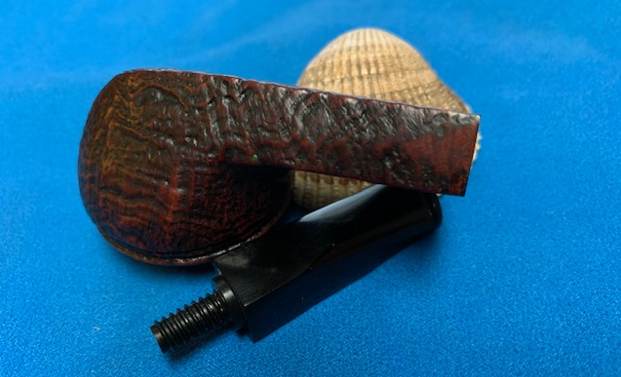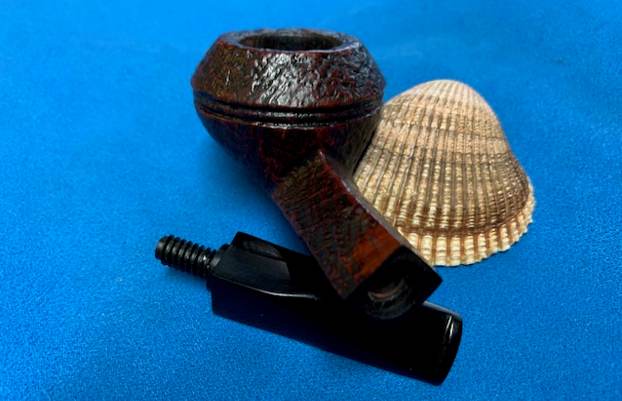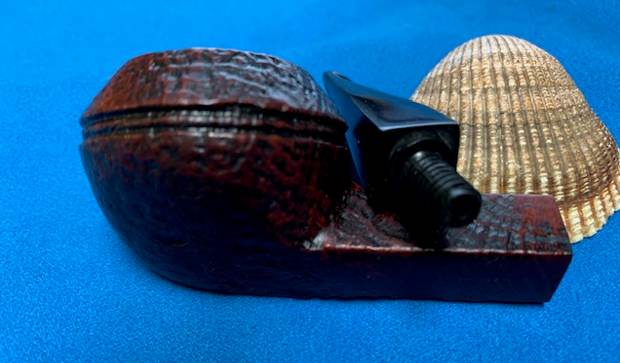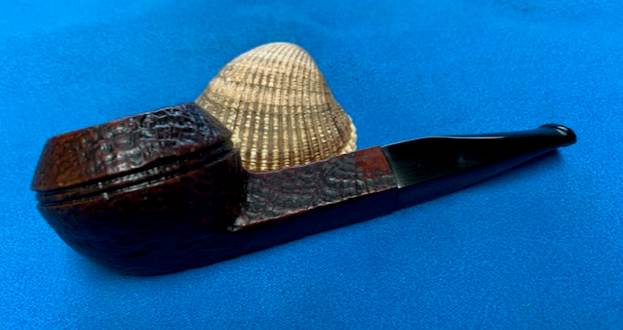Blog by Steve Laug
 I am continuing with the same tack I have taken on the last few pipes I have worked on and take you through my process of working on each pipe that we purchase. Jeff has set up a spread sheet to track where the pipe came from, the date of purchase and what we paid for it so that we know what we have invested in the pipe before we even work on it. This takes a lot of the guess work out of the process. This particular pipe was purchased on 05/25/2022 from an antique store in Portland, Oregon, USA. I also want you to understand why we take the photos we do. It is not accidental or chance as the photos have been taken to help me make an assessment of the pipe Jeff sees before he starts his clean up work. We do this to record the condition that the pipe was in when received it and to assess what kind of work will need to be done on. When I look at these photos this is what I see.
I am continuing with the same tack I have taken on the last few pipes I have worked on and take you through my process of working on each pipe that we purchase. Jeff has set up a spread sheet to track where the pipe came from, the date of purchase and what we paid for it so that we know what we have invested in the pipe before we even work on it. This takes a lot of the guess work out of the process. This particular pipe was purchased on 05/25/2022 from an antique store in Portland, Oregon, USA. I also want you to understand why we take the photos we do. It is not accidental or chance as the photos have been taken to help me make an assessment of the pipe Jeff sees before he starts his clean up work. We do this to record the condition that the pipe was in when received it and to assess what kind of work will need to be done on. When I look at these photos this is what I see.
- The finish is dirty with debris and dust collecting in the twin rings on the bowl cap. The sandblast is quite nice but also very dirty. There appears to be a few nicks along the top of the twin rings around the cap.
- The rim top is dirty and there is a lava overflow from the cake in the bowl and some darkening on the rim top. The sandblast is filled in with lava on some of the rim top and well need to be cleaned out.
- The bowl has a thick cake in it but the inner bevel and outer edge of the bowl actually look to be undamaged other thank the scratches and darkening. There does not appear to be any burning or reaming damage to the edges of the bowl.
- The diamond shaped stem is vulcanite and there is no logo in the surface.
- The vulcanite stem has some light oxidation ahead of the softee bit but was dirty. The softee bit on the stem end kept the stem from having any tooth marks or damage. Interestingly it is also a Jobey Link System stem. There is also some rounding on the shoulder of the stem at the shank junction.
Overall my impressions of this stubby, squat Bulldog was that it was in solid shape some light damage to the twins rings but nothing terrible. The cake does not seem to hide any burns or checking but I will know more once it is cleaned and reamed. The exterior of the bowl does not show any hot spots but with the grime in the sandblast it is very hard to know with certainty. It is a good looking pipe in spite of the poor care it has had. The photos below confirm the assessment above.
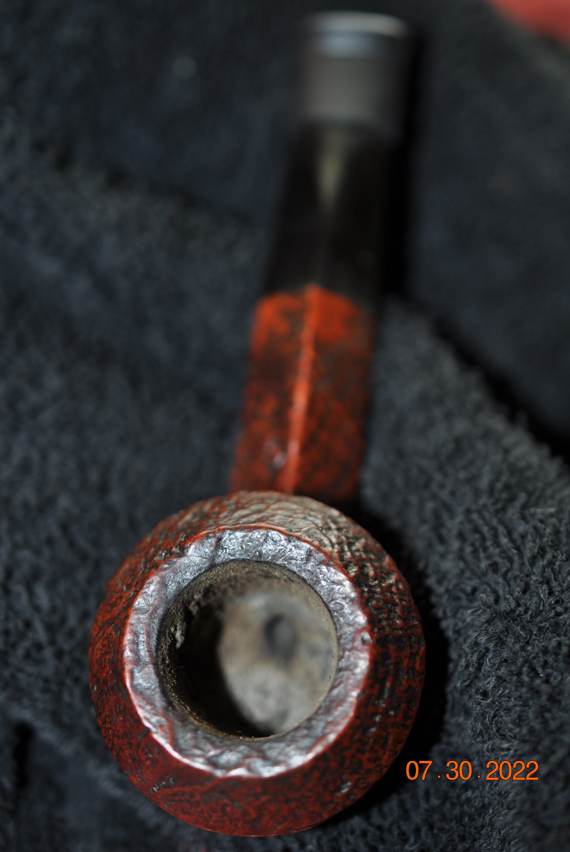 Hopefully as you have learned from the last few blogs we always include close up photos of key areas on the pipe we buy. We do this so that I can have a clearer picture of the condition of the bowl and rim edges and top since Jeff does the clean up and we live quite far apart. The rim top photos confirm my assessment above. The cake in the bowl is quite thick and the rim top has some lava and debris in the grooves of the sandblast. You can also see the condition of the inner and outer edges of the rim. You can see that there does not appear to be any over reaming or burn damage to the edges. This is what I look for when assessing a pipe.
Hopefully as you have learned from the last few blogs we always include close up photos of key areas on the pipe we buy. We do this so that I can have a clearer picture of the condition of the bowl and rim edges and top since Jeff does the clean up and we live quite far apart. The rim top photos confirm my assessment above. The cake in the bowl is quite thick and the rim top has some lava and debris in the grooves of the sandblast. You can also see the condition of the inner and outer edges of the rim. You can see that there does not appear to be any over reaming or burn damage to the edges. This is what I look for when assessing a pipe. 
 His photos of the stem surface confirmed and heightened my assessment of the condition. You can see the light oxidation on the stem surface ahead of the softee bit. You can see the rubber softee bit protected the stem from tooth marks and chatter. Jeff removed the softee bit to confirm the assessment of the conditon of the stem.
His photos of the stem surface confirmed and heightened my assessment of the condition. You can see the light oxidation on the stem surface ahead of the softee bit. You can see the rubber softee bit protected the stem from tooth marks and chatter. Jeff removed the softee bit to confirm the assessment of the conditon of the stem. 
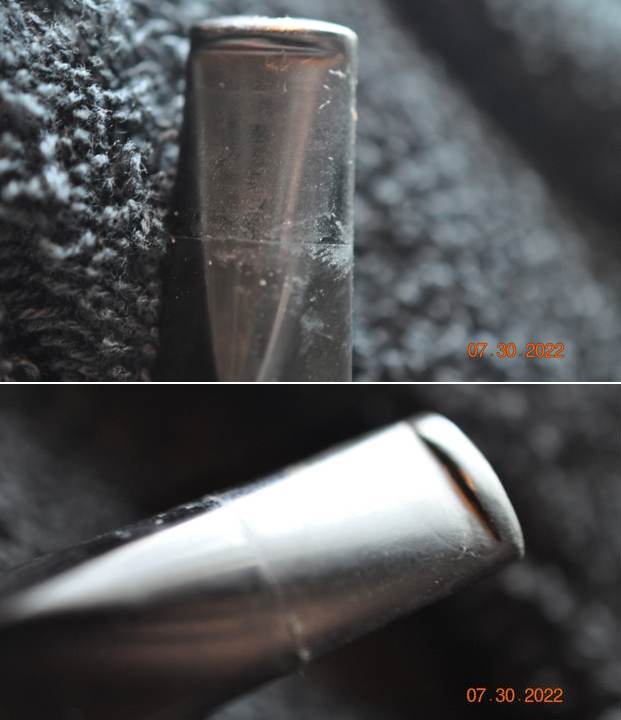 Remember that we include photos of the sides and heel of the bowl for me to do a more thorough assessment of the condition of the briar and the finish before I have it in hand. The finish is dirty but the mixed grain shows through the sandblast nicely and cleaning should remove that. There were no cracks or splits following the grain or coming down from the rim edges. There were no cracks in the shank. In this case the bowl exterior is sound and should clean up very well.
Remember that we include photos of the sides and heel of the bowl for me to do a more thorough assessment of the condition of the briar and the finish before I have it in hand. The finish is dirty but the mixed grain shows through the sandblast nicely and cleaning should remove that. There were no cracks or splits following the grain or coming down from the rim edges. There were no cracks in the shank. In this case the bowl exterior is sound and should clean up very well. 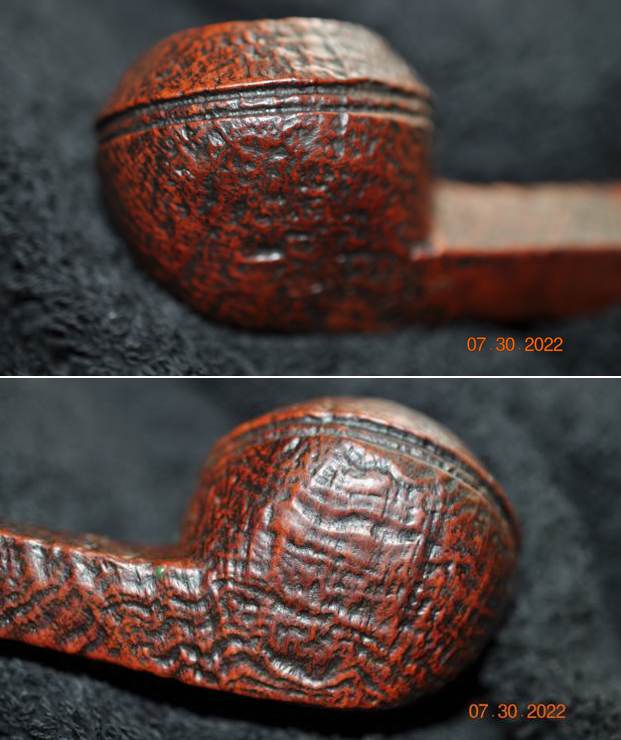
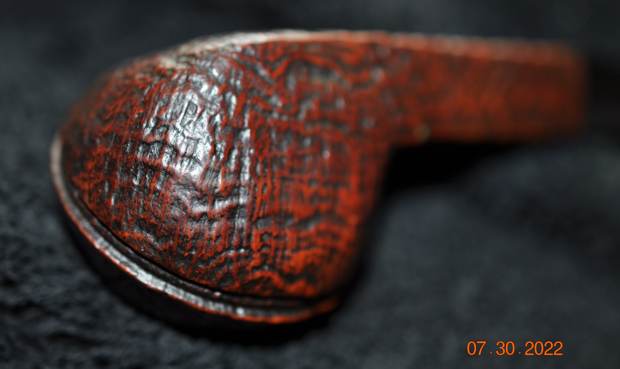 We take photos of the stamping so I can see if it is faint in any spots or double stamped or unclear. It often takes several photos to capture what I am looking for. The stamping on the left underside of the shank is clear and readable in the pictures below. It reads Jobey [over] Shellmoor [over] the shape number 020. The Jobey stamp is faint but still readable as is the second half of the Shellmoor stamp. The shape number is very clear.
We take photos of the stamping so I can see if it is faint in any spots or double stamped or unclear. It often takes several photos to capture what I am looking for. The stamping on the left underside of the shank is clear and readable in the pictures below. It reads Jobey [over] Shellmoor [over] the shape number 020. The Jobey stamp is faint but still readable as is the second half of the Shellmoor stamp. The shape number is very clear.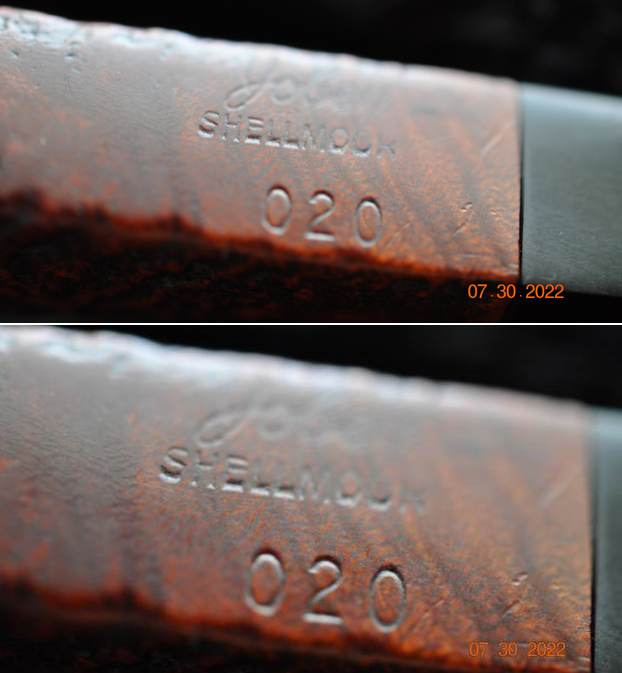 For me researching the brand and the maker are an important part of the restoration process. It gives me the background on the philosophy of the pipemakers as well as an understanding of their perspective in making a pipe. That is why I generally include it in my restoration write ups. It is important for me and it is important in educating us on those who have left behind a rich heritage. A unique feature of this pipe is the Jobey Link feature. I did some digging into the patent for the Link. To get the background information I turned to the US Patent search site and entered the numbers. I was able to find both a description of the invention and a diagram that was submitted with the Patent application. The patent is for the Jobey Link that connects the stem and shank on the pipe. Here is the link to the site and a screen capture of the information found there. https://pdfpiw.uspto.gov/.piw?docid=03537462&SectionNum=1&IDKey=6F776849C285&HomeUrl=http://patft.uspto.gov/netacgi/nph-Parser?Sect1=PTO1%2526Sect2=HITOFF%2526d=PALL%2526p=1%2526u=%25252Fnetahtml%25252FPTO%25252Fsrchnum.htm%2526r=1%2526f=G%2526l=50%2526s1=3537462.PN.%2526OS=PN/3537462%2526RS=PN/3537462
For me researching the brand and the maker are an important part of the restoration process. It gives me the background on the philosophy of the pipemakers as well as an understanding of their perspective in making a pipe. That is why I generally include it in my restoration write ups. It is important for me and it is important in educating us on those who have left behind a rich heritage. A unique feature of this pipe is the Jobey Link feature. I did some digging into the patent for the Link. To get the background information I turned to the US Patent search site and entered the numbers. I was able to find both a description of the invention and a diagram that was submitted with the Patent application. The patent is for the Jobey Link that connects the stem and shank on the pipe. Here is the link to the site and a screen capture of the information found there. https://pdfpiw.uspto.gov/.piw?docid=03537462&SectionNum=1&IDKey=6F776849C285&HomeUrl=http://patft.uspto.gov/netacgi/nph-Parser?Sect1=PTO1%2526Sect2=HITOFF%2526d=PALL%2526p=1%2526u=%25252Fnetahtml%25252FPTO%25252Fsrchnum.htm%2526r=1%2526f=G%2526l=50%2526s1=3537462.PN.%2526OS=PN/3537462%2526RS=PN/3537462
 While I am sure that some of you will skip the next section of this blog I encourage you to read the process that we use to clean our pipes. It is an important part of the our work of restoration. Jeff wrote a detailed blog about his cleaning process. I am including a link to that now so you can see what I mean about his process. Do not skip it! Give it a read (https://rebornpipes.com/2020/01/20/got-a-filthy-estate-pipe-that-you-need-to-clean/). Here is the introduction to that blog and it is very true even to this day.
While I am sure that some of you will skip the next section of this blog I encourage you to read the process that we use to clean our pipes. It is an important part of the our work of restoration. Jeff wrote a detailed blog about his cleaning process. I am including a link to that now so you can see what I mean about his process. Do not skip it! Give it a read (https://rebornpipes.com/2020/01/20/got-a-filthy-estate-pipe-that-you-need-to-clean/). Here is the introduction to that blog and it is very true even to this day.
Several have asked about Jeff’s cleaning regimen as I generally summarize it in the blogs that I post rather than give a detailed procedure. I have had the question asked enough that I asked Jeff to put together this blog so that you can get a clear picture of the process he uses. Like everything else in our hobby, people have different methods they swear by. Some may question the method and that is fine. But it works very well for us and has for many years. Some of his steps may surprise you but I know that when I get the pipes from him for my part of the restoration they are impeccably clean and sanitized. I have come to appreciate the thoroughness of the process he has developed because I really like working on clean pipe!
For the benefit of some of you who may be unfamiliar with some of the products he uses I have included photos of three of the items that Jeff mentions in his list. This will make it easier for recognition. These three are definitely North American Products so you will need to find suitable replacements or order these directly on Amazon. The makeup pads are fairly universal as we were able to pick some up in India when we were with Paresh and his family.
In the blog itself he breaks his process down into two parts – cleaning the stem and cleaning the bowl. Each one has a large number of steps that he methodically does every time. I know because I have watched him do the work and I have seen the pipes after his work on them. He followed this process step by step and when the pipe got to me it was spotlessly clean and ready for my work. The inside of the stem, shank and bowl were clean and to me that is an amazing gift as it means that my work on this end is with a clean pipe! I cannot tell you how much difference that makes for my work.
When the pipe arrives here in Vancouver I have a clean pipe and I go over it keeping in mind my assessment shared in the opening paragraph above. I am looking for any significant structural changes in the bowl and finish as I go over it.
- The finish cleaned up really well and the oils and grime ground into the briar have been removed. The twin rings around the bowl cap are very clean and there was no grime in the grooves. With all the grime removed it was a great looking pipe.
- The rim top cleaned up well and the lava was gone. The inner and outer edges of the bowl looked very good.
- The bowl was very clean and the top and inner edge of the bowl. The bowl walls are also very clean and smooth with no checking or burn marks on the inside or out of the bowl. The walls were undamaged.
- The diamond shaped stem is vulcanite and there is no logo in the surface but it cleaned up very well.
- The vulcanite stem clearly shows the effectiveness of the rubber softee bit in protection the stem from tooth marks. It definitely has some rounding on the stem shoulders at the shank joint. It is bothersome but there is not much that can be done with it. I will try to minimize it but for the most part this is one part of the stem restoration that cannot be undone when done poorly
Hopefully the steps above show you both what I look for when I go over the pipe when I bring it to the work table and also what I see when I look at the pipe in my hands. They also clearly spell out a restoration plan in short form. My work is clear and addressing it will be the next steps. I took photos of the whole pipe to give you a picture of what I see when I have it on the table. This is important to me in that it also shows that there was no damage done during the clean up work or the transit of the pipe from Idaho to here in Vancouver. Also things stand out that I did not see in the photos. For example I had no idea I was working with an orific button rather than a slot but it works with the pipe. I suppose it could be a replacement stem but it appears original other than the lack of a Jobey logo.
 I spent some time going over the bowl and rim top to get a sense of what is happening there. The bowl looked very good and the walls were smooth. There was no damage internally. The rim top was clean and I could clearly see the sandblast around the rim top. It was clean and clear. The inner and outer edge looked very good. I also went over the stem carefully. I examined the stem and the button edge and was happy to see that they were in great condition. I took photos of the rim top and stem sides to show as best as I can what I see when I look at them.
I spent some time going over the bowl and rim top to get a sense of what is happening there. The bowl looked very good and the walls were smooth. There was no damage internally. The rim top was clean and I could clearly see the sandblast around the rim top. It was clean and clear. The inner and outer edge looked very good. I also went over the stem carefully. I examined the stem and the button edge and was happy to see that they were in great condition. I took photos of the rim top and stem sides to show as best as I can what I see when I look at them. As usual I checked the stamping to make sure that the clean up work did not damage the stamping on the shank in any way. I know Jeff is cognizant of this but I do it anyway and take a photo to show what I see when I examine it. In this case it seems more readable than before the clean up. It is clear and distinct. I removed the stem from the shank and checked the tenon. You can see the Jobey Link System Tenon. It is threaded and screw into the shank. The other end is smooth and fits by friction in the stem. I lay the parts of the pipe out to get a sense of the proportion that was in the mind of the pipe maker when he crafted the pipe. It is a beauty in flow and shape.
As usual I checked the stamping to make sure that the clean up work did not damage the stamping on the shank in any way. I know Jeff is cognizant of this but I do it anyway and take a photo to show what I see when I examine it. In this case it seems more readable than before the clean up. It is clear and distinct. I removed the stem from the shank and checked the tenon. You can see the Jobey Link System Tenon. It is threaded and screw into the shank. The other end is smooth and fits by friction in the stem. I lay the parts of the pipe out to get a sense of the proportion that was in the mind of the pipe maker when he crafted the pipe. It is a beauty in flow and shape. This is one of my unusual restorations – I did not need to do work on the rim top or edges and the shank was clean. When I get a bowl that is this clean I use Before & After Restoration Balm. It is a paste/balm that is rubbed into the surface of the briar. The product works to deep clean the finish, enliven and protect the briar. I worked it into the briar with my finger tips to make sure that it covers every square inch of the pipe. I used a horsehair shoe brush to get into the twin rings around the cap. I set it aside for 10 minutes to let it do its work. Once the time has passed I wiped it off with a soft cloth then buffed it with a cotton cloth. The briar really began to have a deep shine. The photos I took of the bowl at this point mark the progress in the restoration. You see the shine that the briar has taken on and the depth that the sandblast finish has. It is a gorgeous pipe.
This is one of my unusual restorations – I did not need to do work on the rim top or edges and the shank was clean. When I get a bowl that is this clean I use Before & After Restoration Balm. It is a paste/balm that is rubbed into the surface of the briar. The product works to deep clean the finish, enliven and protect the briar. I worked it into the briar with my finger tips to make sure that it covers every square inch of the pipe. I used a horsehair shoe brush to get into the twin rings around the cap. I set it aside for 10 minutes to let it do its work. Once the time has passed I wiped it off with a soft cloth then buffed it with a cotton cloth. The briar really began to have a deep shine. The photos I took of the bowl at this point mark the progress in the restoration. You see the shine that the briar has taken on and the depth that the sandblast finish has. It is a gorgeous pipe.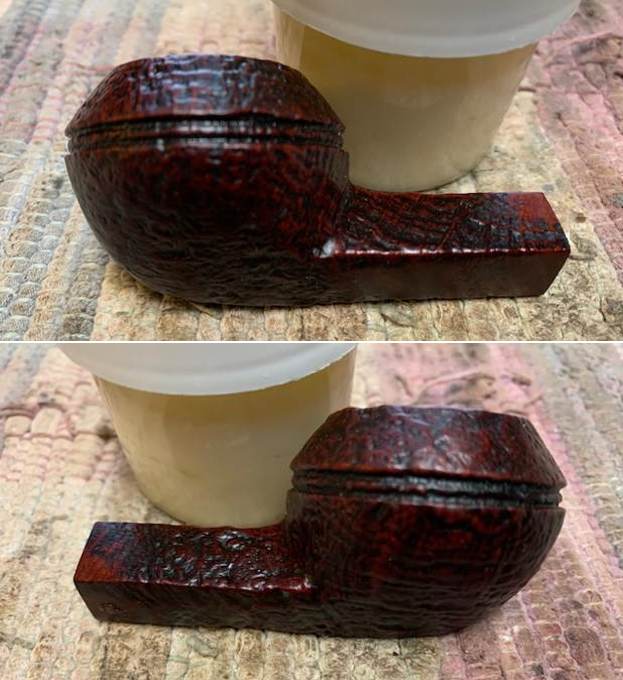

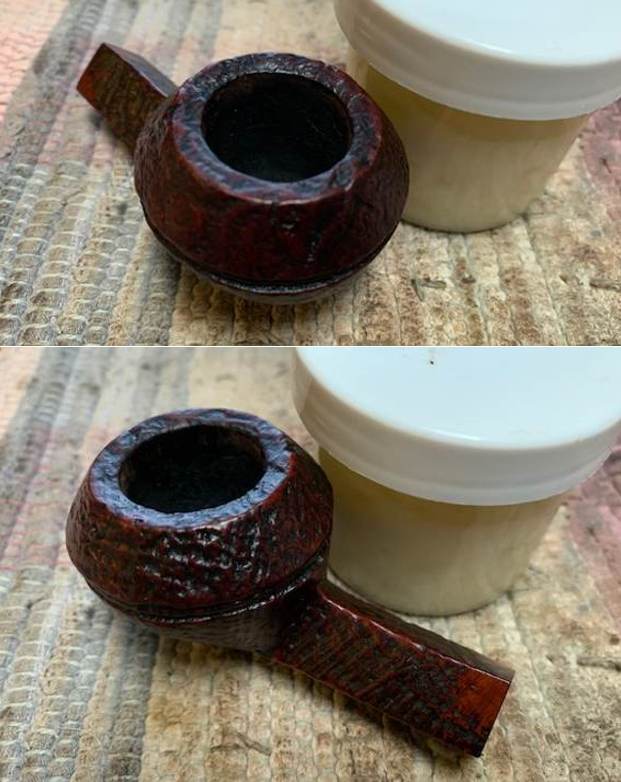 Now it was time to address the part of the restoration I leave until last. It is one of the rare cases where it was not a big deal so I could easily have started with it but old habits die hard! I set the bowl aside and turned my attention to the stem. Fortunately it took very little work as there were no tooth marks. It was the time now to polish the stem and bring back a shine. Over the years I have developed my own process for this. It is all preparation for the buffing that will come last. I use micromesh sanding pads and water to wet sand the stem with 1500-12000 grit sanding pads. I wiped it down after each sanding pad with Obsidian Oil on a cotton rag after each sanding pad as I find it does two things – first it protects the vulcanite and second it give the sanding pads some bite in the polishing process. I sought with the sanding pads to square up the sides to reduce the rounded shoulders on the stem sides and while it helped it was still not perfect.
Now it was time to address the part of the restoration I leave until last. It is one of the rare cases where it was not a big deal so I could easily have started with it but old habits die hard! I set the bowl aside and turned my attention to the stem. Fortunately it took very little work as there were no tooth marks. It was the time now to polish the stem and bring back a shine. Over the years I have developed my own process for this. It is all preparation for the buffing that will come last. I use micromesh sanding pads and water to wet sand the stem with 1500-12000 grit sanding pads. I wiped it down after each sanding pad with Obsidian Oil on a cotton rag after each sanding pad as I find it does two things – first it protects the vulcanite and second it give the sanding pads some bite in the polishing process. I sought with the sanding pads to square up the sides to reduce the rounded shoulders on the stem sides and while it helped it was still not perfect. 
 After finishing with the micromesh pads I always rub the stem down with Before & After Fine and Extra Fine stem polish as it seems to really remove the fine scratches in the vulcanite. I rub the Fine Polish on the stem and wipe it off with a paper towel and then repeat the process with the Extra Fine polish. I finish the polishing of the stem by wiping it down with a final coat of Obsidian Oil and set the stem aside to let the oil absorb. This process gives the stem a shine and also a bit of protection from oxidizing quickly.
After finishing with the micromesh pads I always rub the stem down with Before & After Fine and Extra Fine stem polish as it seems to really remove the fine scratches in the vulcanite. I rub the Fine Polish on the stem and wipe it off with a paper towel and then repeat the process with the Extra Fine polish. I finish the polishing of the stem by wiping it down with a final coat of Obsidian Oil and set the stem aside to let the oil absorb. This process gives the stem a shine and also a bit of protection from oxidizing quickly. The final steps in my process involve using the buffer. I first buff the stem and the briar with Blue Diamond on the buffing wheel. Blue Diamond is a plastic polish but I find that it works very well to polish out the light scratches in the vulcanite and the briar. I work the pipe over on the wheel with my finger or thumb in the bowl to keep it from becoming airborne. It works well and I am able to carefully move forward with the buffing. I lightly buff sandblast bowl and shank making sure to keep the product from building up in the grooves of the finish.
The final steps in my process involve using the buffer. I first buff the stem and the briar with Blue Diamond on the buffing wheel. Blue Diamond is a plastic polish but I find that it works very well to polish out the light scratches in the vulcanite and the briar. I work the pipe over on the wheel with my finger or thumb in the bowl to keep it from becoming airborne. It works well and I am able to carefully move forward with the buffing. I lightly buff sandblast bowl and shank making sure to keep the product from building up in the grooves of the finish.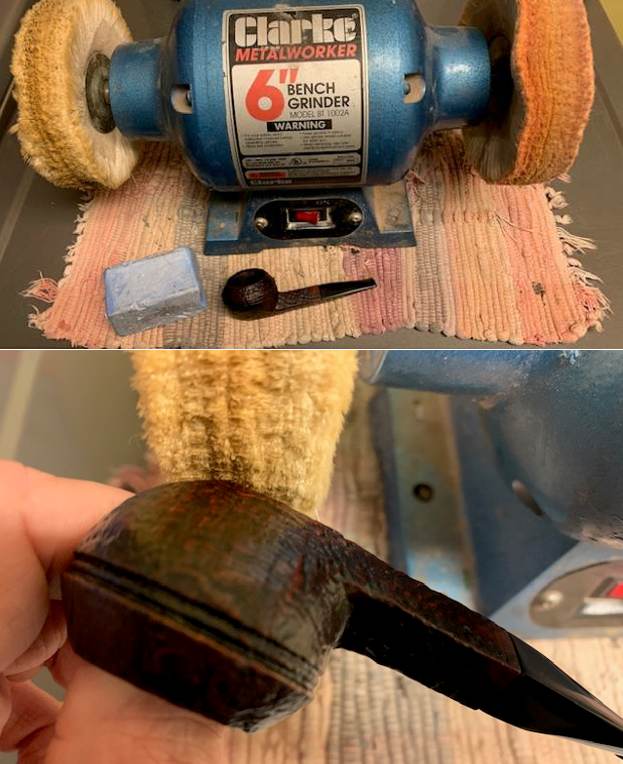
 I finished with the Blue Diamond and moved on to buffing with carnauba wax. Once I have a good shine in the briar and vulcanite I always give the bowl and the stem multiple coats of carnauba wax. I have found that I can get a deeper shine if I following up the wax buff with a clean buffing pad. It works to raise the shine and then I follow that up with a hand buff with a microfiber cloth to deepen the shine. It is always fun for me to see what the polished bowl looks like with the polished vulcanite stem. This Jobey really is a beautiful pipe. The sandblast finish around the bowl sides and shank highlights the mix of grain shining through the rich brown stains of this Jobey Shellmoor 020 Squat Bulldog. The finished pipe feels great in my hand. It is light and well balanced. Have a look at it with the photos below. The dimensions are Length: 5 inches, Height: 1 ½ inches, Outside diameter of the bowl: 1 ¼ inches, Chamber diameter: 7/8 of an inch. The weight of the pipe is 1.16 ounces/33 grams. It is a beautiful pipe and one that I will be putting on the rebornpipes store in the American (US) Pipe Maker section.
I finished with the Blue Diamond and moved on to buffing with carnauba wax. Once I have a good shine in the briar and vulcanite I always give the bowl and the stem multiple coats of carnauba wax. I have found that I can get a deeper shine if I following up the wax buff with a clean buffing pad. It works to raise the shine and then I follow that up with a hand buff with a microfiber cloth to deepen the shine. It is always fun for me to see what the polished bowl looks like with the polished vulcanite stem. This Jobey really is a beautiful pipe. The sandblast finish around the bowl sides and shank highlights the mix of grain shining through the rich brown stains of this Jobey Shellmoor 020 Squat Bulldog. The finished pipe feels great in my hand. It is light and well balanced. Have a look at it with the photos below. The dimensions are Length: 5 inches, Height: 1 ½ inches, Outside diameter of the bowl: 1 ¼ inches, Chamber diameter: 7/8 of an inch. The weight of the pipe is 1.16 ounces/33 grams. It is a beautiful pipe and one that I will be putting on the rebornpipes store in the American (US) Pipe Maker section.
Hopefully this tack of writing this blog is helpful to you in some way. In it I show both what I am looking for and how I move forward in addressing what I see when I work on a pipe has been helpful to you. It is probably the most straightforward detailed description of my work process. As always I encourage your questions and comments as you read the blog. Thanks to each of you who are reading this blog. Remember we are not pipe owners; we are pipemen and women who hold our pipes in trust until they pass on into the trust of those who follow us.

